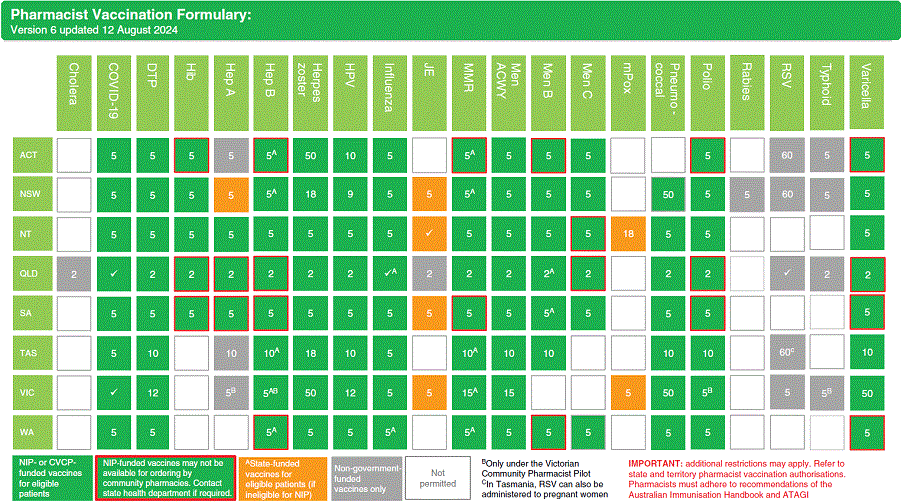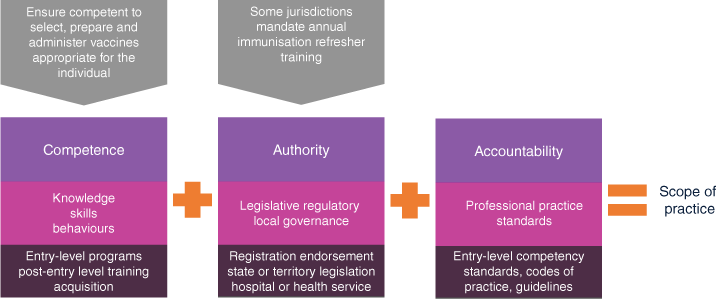The evolving role of Australian community pharmacists in vaccination: challenges and opportunities
Brenton Hart A *A

Brenton Hart B.Pharm(Hons) MPS is the Chief Pharmacist for TerryWhite Chemmart, Australia’s largest community pharmacy network. A passionate advocate and community pharmacist, Brenton has extensive experience in clinical practice, pharmacy operations, business, and professional education. Known for his leadership in public health, vaccination, and pharmacist prescribing, he is dedicated to driving positive health outcomes across Australia and empowering pharmacists to lead in primary healthcare by utilising their full scope of practice. |
Abstract
Community pharmacists in Australia are increasingly at the forefront of public healthcare, expanding their scope of practice since first providing immunisation services in 2014. This article examines the evolving role of pharmacists, highlighting their significant contributions to vaccination efforts. Despite their growing impact, pharmacists face complexities due to varying regulatory frameworks and scope of practice across Australian jurisdictions. These challenges affect service consistency and consumer experience. Opportunities for community pharmacies to enhance and strengthen their care of communities remain, including initiatives like the National Immunisation Program Vaccinations in Pharmacy (NIPVIP), which enhances vaccine accessibility and affordability and travel advice and vaccination. Community pharmacists also play a critical role in public health promotion, opportunistic immunisation and support when disease outbreaks occur. To maximise their value, the healthcare system must address regulatory inconsistencies and promote multidisciplinary collaboration. By overcoming these barriers, community pharmacies can continue to provide accessible, high-quality care, reinforcing their essential role in public health and vaccination services.
Keywords: community pharmacy, immunisation, public health, regulatory challenges, scope of practice, vaccination.
The expanding role of pharmacists
Community pharmacists are at the forefront of public healthcare in Australia, with over 5800 community pharmacies providing essential services to millions of patients annually.1 Pharmacists first began providing immunisation services to Australians in 2014, and the scope of practice for pharmacists has been expanding since, including structured prescribing treatments for urinary tract infections and the renewal of oral contraceptives, with autonomous prescribing pilots underway in Queensland, Australia. This evolution is exciting but also presents complexities, particularly in the realm of public and preventative health.
Service data show that Australians are increasingly choosing community pharmacies for their vaccination needs. For instance, in 2023 community pharmacies administered over 2.2 million influenza vaccinations, accounting for ~24% of the total market share to October of that year.2 Community pharmacists also administered more than 11.6 million COVID-19 vaccinations as of January 2024, and at their peak, accounted for ~50% of COVID-19 vaccinations administered in March 2023.3 This demonstrates the increasingly critical role that pharmacists now play in providing accessible public health care, particularly in driving opportunistic vaccination.
The number of vaccine-preventable diseases that community pharmacists can administer vaccines for has increased rapidly since the beginning of the COVID-19 pandemic. Prior to the pandemic, community pharmacists primarily administered influenza, pertussis and measles, mumps and rubella vaccinations. This has since expanded to nearly all available vaccines; now covering 21 vaccine-preventable diseases,4 of which there are a range of different vaccine brands, dosages, administration requirements, and other unique factors such as minimum patient ages that determine eligibility and that must be considered as part of the immunisation service.
To further complicate this professional practice landscape, each Australian State or Territory has its own immunisation schedule, as well as nuances such as funding for the administration of selected vaccines and haphazard vaccine stock that is made available from Australian jurisdictional Health Department stockpiles (versus that from the private sector).3
A view of the complexities affecting pharmacist practice in the context of vaccination services at the time of writing is presented in Fig. 1.
Pharmacist Vaccination Formulary and Funding Mechanism by Jurisdiction as of 12 August 2024. The number in each box indicates the minimum age a pharmacist is legally permitted to administer the vaccine. This age may differ from the recommendations in the Australian Immunisation Handbook or the product information for each vaccine. Please note: this figure does not constitute professional practice advice and pharmacists must ensure their practice adheres to the relevant recommendations in the Australian Immunisation Handbook as well as their local regulations and guidelines.

Challenges in scope of practice
Scope of practice is a time-sensitive, dynamic concept that defines the professional activities a pharmacist is educated, competent and authorised to perform, and for which they are accountable.5
The scope of practice for pharmacists is governed by a range of factors which are summarised in Fig. 2. Unlike most other healthcare professions, the scope of practice for community pharmacists varies significantly across all Australian jurisdictions.
For example, from a regulatory and authorisation perspective; no two Australian jurisdictions are completely identical in terms of the vaccines that can be administered by community pharmacists, and this extends to the age groups of patients that can receive vaccines from a community pharmacist.4
Further, in order to maintain competency, some jurisdictions mandate annual vaccination refresher training, whereas others do not. Another example is that, until recently, Victoria was the only Australian jurisdiction where intern pharmacists who have completed the required immunisation training could not administer vaccines under supervision. These complexities create a difficult landscape for pharmacists, particularly those that practice across jurisdictional borders, as well as pharmacy groups that operate and promote these services across multiple jurisdictions or from a national perspective. This results in increased workload to provide clinical support, as well as a diminished ability for consumers to easily navigate vaccine eligibility and book for immunisation services, among other functions.
Consistency in professional practice and clinical governance standards in community pharmacies is safeguarded by the Quality Care Pharmacy Program (QCPP), which provides a quality assurance framework according to the Australian Standard. However, regulatory inconsistencies remain a barrier to the level of care pharmacists can provide. These inconsistencies also affect consumer experience and engagement, particularly in managing vaccination services.
Collaboration and multidisciplinary care are key themes within Australia’s Primary Health Care 10 Year Plan 2022–2032.7 However, there have been criticisms from various medical peak bodies, particularly during the COVID-19 outbreak, regarding the expansion of pharmacy vaccination services.8,9 These criticisms go beyond the operational and regulatory challenges mentioned earlier. This ongoing dialogue between healthcare professions presents its own challenge, highlighting the need for further collaboration and understanding in delivering optimal patient care.
Opportunities for community pharmacies
Community pharmacists remain the most accessible and one of the most trusted health care providers in Australia.1 Community pharmacists continue to advocate for a greater role in primary care and have consistently expressed a strong desire to support initiatives that drive vaccination uptake, such as free influenza vaccination programs.
In 2024, the National Immunisation Program Vaccinations in Pharmacy (NIPVIP) Program was established to increase patient access and affordability of vaccinations to help protect Australians from vaccine-preventable diseases.10 This program allows eligible patients to access free National Immunisation Program (NIP) vaccines in a community pharmacy, with no out-of-pocket costs – a privilege that was previously only afforded to other registered healthcare professionals that administer vaccines in Australia.
In an effort to drive vaccination rates, numerous Australian jurisdictions have implemented free influenza vaccination programs in recent years and community pharmacy is best placed to implement these initiatives.11,12
Travel advice and vaccination are other opportunities, with many Australians unaware of this recommended avenue of preventative care. A growing number of jurisdictions support pharmacists in providing opportunistic travel advice and administering travel vaccinations.4,13,14
Owing to their retailing expertise and operations, community pharmacies also play a crucial role in public health promotion. Dedicated educational campaigns, such as those for pertussis vaccination services have anecdotally shown excellent results in increasing awareness and driving opportunistic vaccination rates. Pharmacies are also ideally positioned to scale up immunisation operations during disease outbreaks, leveraging their trusted position in local communities as illustrated during the outbreak of Japanese encephalitis in Victoria in early 202215 or one of the numerous and ongoing outbreaks of pertussis in various locations across Australia.16
The path forward
To maximise the value pharmacists bring to their communities and the broader healthcare system, several key issues need addressing. Consistency in regulations and scope of practice, removal of practice restrictions, and harmonisation of regulatory frameworks are essential.
Australian health consumers will also benefit from clearer and simplified eligibility criteria for vaccinations available through their community pharmacy.
The Unleashing the potential of our health workforce – scope of practice review17 has highlighted the need for all healthcare professionals, including pharmacists to practice at their full scope, as well as a number of the issues and barriers discussed in this article.
Overall, as pharmacists continue to build their scope and continue to play a broader role in primary and preventative public healthcare. Moving forward, collaboration and multi-disciplinary care with other allied health teams, and a ‘no wrong door’ approach to vaccination will be crucial for improving public health outcomes for Australians.
Conclusion
Community pharmacists are uniquely positioned to enhance public health through vaccination services. Despite the challenges posed by regulatory inconsistencies and expanding scopes of practice, pharmacists have demonstrated their critical role in public health. By addressing these challenges and leveraging the opportunities available, community pharmacies can continue to be at the forefront of vaccination efforts, providing accessible, convenient and high-quality care to their communities.
Data availability
The data that support this paper are available in the paper or from references in the reference list.
Conflicts of interest
The author declares they are an employee of TW&CM Pty Ltd trading as TerryWhite Chemmart and a community pharmacy proprietor. The author declares that they have no other conflicts of interest.
References
1 The Pharmacy Guild of Australia (2024) About the Guild. The Pharmacy Guild of Australia. https://www.guild.org.au/about-us (accessed 9 August 2024)
2 Australian Government Department of Health and Aged Care (2023) Influenza (flu) immunisation data. Commonwealth of Australia. https://www.health.gov.au/resources/collections/influenza-flu-immunisation-data (accessed 9 August 2024)
3 Australian Government Department of Health and Aged Care (2023) COVID-19 vaccination – vaccination data – 3 March 2023. Commonwealth of Australia. https://www.health.gov.au/resources/publications/covid-19-vaccination-vaccination-data-3-march-2023 (accessed 9 August 2024)
4 Pharmaceutical Society of Australia (2024) Pharmacist administered vaccinations. PSA. https://www.psa.org.au/state-vaccination-regulations/ (accessed 9 August 2024)
5 Pharmacy Guild of Australia (2022) Scope of Practice of Community Pharmacists Report. Pharmacy Guild of Australia. https://www.guild.org.au/__data/assets/pdf_file/0023/106178/scope-of-practice-2023.pdf
6 Poudel A et al. (2020) Unleashing our potential: pharmacists’ role in vaccination and public health. Sr Care Pharm 35, 372-378.
| Crossref | Google Scholar | PubMed |
7 Australian Government Department of Health and Aged Care (2022) Australia’s primary health care 10 year plan 2022–2032. Commonwealth of Australia. https://www.health.gov.au/resources/publications/australias-primary-health-care-10-year-plan-2022-2032?language=en (accessed 13 October 2024)
8 Tsirtsakis A (2021) Concerns raised over pharmacists’ role in COVID vaccine rollout. In NewsGP, 7 January 2021. RACGP. Available at https://www1.racgp.org.au/newsgp/professional/concerns-raised-over-pharmacists-role-in-covid-vac (accessed 13 October 2024)
9 RACGP Media (2022) RACGP and AMA warning on immunisation program decision for Western Australia. 21 April 2022. Royal Australian College of General Practitioners. https://www.racgp.org.au/gp-news/media-releases/2022-media-releases-1/april-2022/racgp-and-ama-warning-on-immunisation-program-deci (accessed 13 October 2024)
10 Pharmacy Programs Administrator (2024) National Immunisation Program Vaccinations in Pharmacy (NIPVIP) Program. PPA. http://www.ppaonline.com.au/programs/national-immunisation-program-vaccinations-in-pharmacy-program (accessed 9 August 2024)
11 Queensland Health (2024) 2024 free flu vaccination program. The State of Queensland. https://www.health.qld.gov.au/clinical-practice/guidelines-procedures/diseases-infection/immunisation/service-providers/2024-free-flu-vaccination-program (accessed 14 August 2024)
12 Government of Western Australia Department of Health (2024) Influenza immunisation. WA Health, Government of Western Australia. https://www.health.wa.gov.au/articles/f_i/influenza-immunisation-program (accessed 14 August 2024)
13 Lyons A (2016) Before they go. Good Practice 7, 14-16 https://www.racgp.org.au/download/Documents/Good%20Practice/2016/July/GP2016July-Travel-Medicine.pdf (accessed January 2024).
| Google Scholar |
14 Herman J, Patel D (2018) Advising the traveller. Medicine 46, 59-65.
| Crossref | Google Scholar | PubMed |
15 Department of Jobs, Precincts and Regions (2024) Japanese encephalitis current situation. Agriculture Victoria. https://agriculture.vic.gov.au/biosecurity/animal-diseases/important-animal-diseases/japanese-encephalitis/japanese-encephalitis-current-situation (accessed 14 August 2024)
16 Luu LDW (2024) Whooping cough is surging in Australia – what’s the best protection? University of Technology—Sydney. https://www.uts.edu.au/news/health-science/whooping-cough-surging-australia-whats-best-protection (accessed 14 August 2024)
17 Australian Government Department of Health and Aged Care (2024) Unleashing the potential of our health workforce – scope of practice review. Commonwealth of Australia. http://www.health.gov.au/our-work/scope-of-practice-review (accessed 14 August 2024)
 Brenton Hart B.Pharm(Hons) MPS is the Chief Pharmacist for TerryWhite Chemmart, Australia’s largest community pharmacy network. A passionate advocate and community pharmacist, Brenton has extensive experience in clinical practice, pharmacy operations, business, and professional education. Known for his leadership in public health, vaccination, and pharmacist prescribing, he is dedicated to driving positive health outcomes across Australia and empowering pharmacists to lead in primary healthcare by utilising their full scope of practice. |



